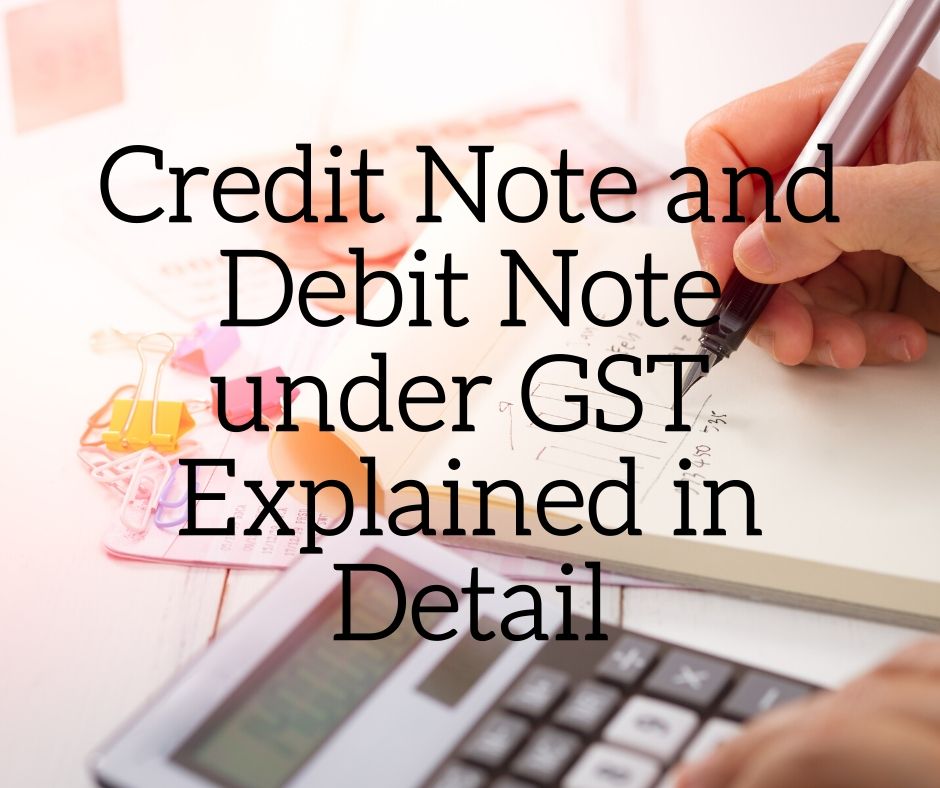Credit Note and Debit Note under GST | Explained in Detail
- 3 April 2020 | 1230 Views | By Mint2Save

Credit Note and Debit Note, what do these terms mean in the tax regime of GST? The concept of such technical terms is not new at all. However, when it comes to taxes, some technical terms completely throw us off, especially when it comes to ‘GST.’ A rather new word in the world of commerce, GST stands for goods and service tax. Anyone associated with business, small or big, knows how important this newly coined term has gained importance. GST is implied in selling, manufacturing, and consuming any product or service in this country. It is the tax that wraps up all the fees imposed by the central as well as the state government of India.

With the introduction of GST, some keynotes to understand this tax regime, one must be acquainted with the concepts of ‘debit note’ and ‘credit note’ in GST. This article gives a detailed explanation of these concepts and the areas or situations under which this concept might be encountered.
What is debit and credit?
Let’s get one thing clear before we start with anything else, what is credit and what is Debit.
Yes, we do know what both these words signify, but let’s be honest that we do tend to get confused at times. Credit means that money is entering the bank account; Debit means cash is deducted from the bank account.
Now that the confusion of credit and Debit is cleared let us consider some situations to understand credit note and debit note.
What is credit note and debit note with example?
Consider you have brought a pretty looking dress from an online e-commerce website. Upon its delivery, you observe that the suit is not what you saw online. The color is not the same, the quality is a bit questionable, and the product is not up to the mark.
However, you have already paid for the dress before its arrival. You decide to return the dress and get back the money you paid for it. In this scenario, you are the customer, and the seller is the site from where you purchased the dress.
Under the given circumstances, the seller will pay you for returning their product. So the transaction from the seller’s bank account is a debit type transaction as money from the seller’s account is getting deducted. Hence to simplify the whole situation, we can say that a credit will be reflected in the customer’s bank account from the seller’s account.
To put this in context of debit note and credit note, we say that the customer implements a debit note to the seller, which accounts for the Debit in his or her account for the purchase made. In response to this debit note, the seller implements a credit note for its customer. So the balance sheet reflects a credit for the customer from the seller.
What is the main purpose of a credit note?
In another situation, you may encounter a situation wherein you like the dress and also order a pair of earrings with the dress. However, due to a technical glitch or some other problem, the price you pay for the earrings is less than its cost price. In such a scenario, the case of implementing the credit and debit note gets reversed.
The seller takes record of this case and issues the seller issues a debit note to the purchaser. The purchaser acknowledges this note and issues a credit note for the same.
Thus, from the above two situations, we can summarise that credit and debit note occur in the following two ways :
- Customer to the seller, the money transaction reduces. The invoice amount for the purchase decreases.
- Customers to the seller, the money transaction increases. The invoice amount for the purchase increases.
How do you show debit and credit note in GST return?
Now let us see all the circumstances under which debit and credit notes are issued for GST.
Why credit note is issued?
Cases when the seller issues Credit Note in GST
- The value for tax tariff gets printed, but somehow it shows that the value exceeds the original amount that is supposed to be taxable. This can be a case of miscalculation or an instance of malpractice. In either case, the seller needs to take responsibility and issue a credit note.
- Similarly, when a tax invoice is implemented with a tax value more than what is permissible, a credit note must be issued.
- The purchaser returns the item bought to the seller ( the case explained in the previous section).
- An extension to the above example, there might not be an item but a service that might be conceived by the customer. However, if the service provided is not up to the desirable standard, a credit note is issued.
It must be noted that the credit indicates that the seller or vendor issues in any of the scenarios, as mentioned above, must be done through a secondary invoice.
Who issues a debit note? How do I write a GST debit note?
Cases when seller issues Debit Note in GST
- In contrast to the above situations, when the value for tax tariff gets printed, but somehow it shows that the cost is lesser than the original taxable value. This can be a case of miscalculation or an instance or negligence. In either case, the seller needs to take notice and issue a debit note.
- Similarly, when a tax invoice is implemented with a tax value less than what is required, the seller issues a debit note. This can be a possible explanation for the example explained above.
In this situation, too, the debit note must be implemented through a supplementary invoice.
With sound knowledge in issuing the credit note as well as the debit note, now we must also know what all are required to be mentioned in such records.
What is Credit Note format?
What all is mentioned in the Credit Note and Debit Note in GST?
Simply knowing when to issue a credit note and when to issue a debit note won’t suffice. The main deal is to remember the details that go into creating these notes. Here is a list of most important information that must be included in the notes :
- Name of the Seller: This is the first identity of the seller to be documented in the credit/debit note.
- Address of the Seller: Address is a must as it gave authentication to the note.
- GSTIN of the Seller: The GSTIN number or code is necessary for the unique identification of the note.
- Type of Note: The specification of the record must be documented.
- Serial Number: A alphanumeric code that helps in keeping a history of the note issued.
- Details of the buyer: The name and address of the buyer must be printed on the note. If there is any additional unique information of the customer, it should also be documented.
- The serial number of the original invoice of the purchase: This serial number is required for referencing of the original purchase and the transaction associated with it.
- Details of the tax: All the details of the taxable charge for the good or service that has been incurred must be mentioned. The rates with proper calculations in removing the air of ambiguity of the note issued.
- Signature: This validates the note. Thus, the original signature or a stamp from the seller must be there on the note.
- Date: The date of the purchase, along with the time of the issue of the note helps to keep track of the transactions.
These are the ten details to record the taxes under GST for the seller. There is no fixed upper limit or fixed lower limit for issuing either debit note or credit note. Both can be published as and when the need be.
How do you show debit and credit note in GST return?
Another essential aspect of the issue of these notes, which directly correlates with GST, is the fact that the effect of such notes must be recorded in the GST returns. It can be recorded in the return of the same month in which the bill has been issued. Also, it can be carried forward to the next month. However, missing any record might create a problem for the seller.
Hence, it is always advisable to file the issue of the notes in the GST returns in the same month of its effect. This prevents an additional loss that might be incurred for the wrong filing of the GST return. The generation of a credit or debit note can be quickly done through much online software, and it is a piece of cake. The debit and credit note must be issued before September, which follows the date of the purchase or the time of filing the GST return.









